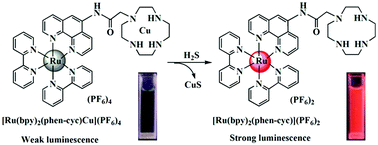A novel dinuclear ruthenium(ii)–copper(ii) complex-based luminescent probe for hydrogen sulfide†
Abstract
A novel dinuclear ruthenium(II)–copper(II) complex, [Ru(bpy)2(phen-cyc)Cu](PF6)4 (bpy: 2,2′-bipyridine; cyc: 1,4,7,10-tetraazacyclododecane; phen: 1,10-phenanthroline), has been designed and synthesized by conjugating a ruthenium(II) complex with a cyclen-Cu2+ complex. This has almost no luminescence due to the efficient quenching by Cu2+ of the luminescence of the ruthenium(II) complex. In aqueous media, the reaction of [Ru(bpy)2(phen-cyc)Cu](PF6)4 with hydrogen sulfide results in the release of the Cu2+ from the azamacrocyclic ring, accompanied by a ∼130-fold increase in the luminescence intensity at 605 nm with a 159 nm Stokes shift. The dose-dependent luminescence enhancement shows a good linearity in a concentration range of 2.0 to 20 μM, with a detection limit of 21.6 nM for hydrogen sulfide. In addition, the luminescence response of [Ru(bpy)2(phen-cyc)Cu](PF6)4 to hydrogen sulfide is very rapid and widely available in the pH range of 3.0–9.5. It also has excellent selectivity so it can distinguish hydrogen sulfide with no interference by other anions and amino acids. On the basis of these features, a rapid, highly selective and sensitive luminescence method for the detection of hydrogen sulfide under physiological conditions was established, using [Ru(bpy)2(phen-cyc)Cu](PF6)4 as a probe.


 Please wait while we load your content...
Please wait while we load your content...